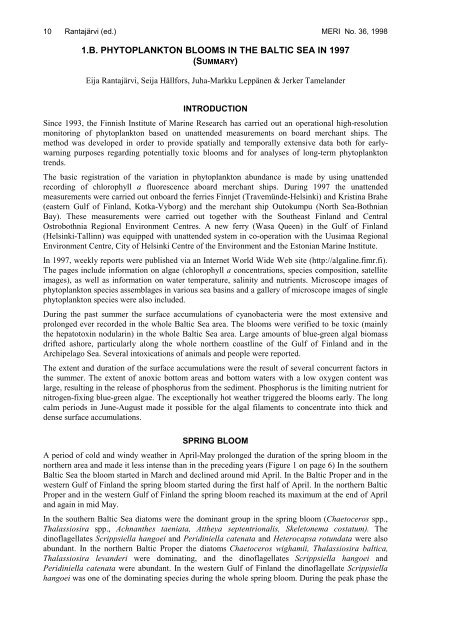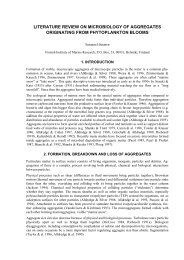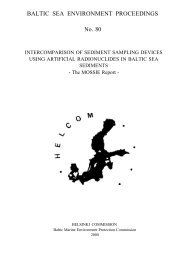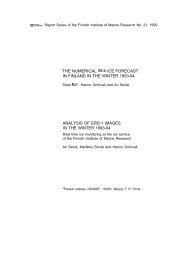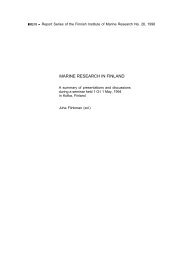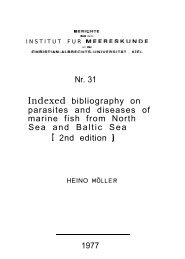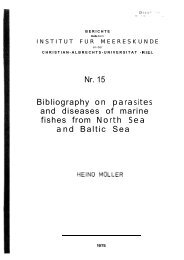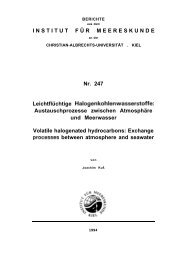Leväkukintatilanne Suomen merialueilla ja varsinaisella Itämerellä
Leväkukintatilanne Suomen merialueilla ja varsinaisella Itämerellä
Leväkukintatilanne Suomen merialueilla ja varsinaisella Itämerellä
Create successful ePaper yourself
Turn your PDF publications into a flip-book with our unique Google optimized e-Paper software.
10<br />
Rantajärvi (ed.) MERI No. 36, 1998<br />
1.B. PHYTOPLANKTON BLOOMS IN THE BALTIC SEA IN 1997<br />
(SUMMARY)<br />
Ei<strong>ja</strong> Rantajärvi, Sei<strong>ja</strong> Hällfors, Juha-Markku Leppänen & Jerker Tamelander<br />
INTRODUCTION<br />
Since 1993, the Finnish Institute of Marine Research has carried out an operational high-resolution<br />
monitoring of phytoplankton based on unattended measurements on board merchant ships. The<br />
method was developed in order to provide spatially and temporally extensive data both for earlywarning<br />
purposes regarding potentially toxic blooms and for analyses of long-term phytoplankton<br />
trends.<br />
The basic registration of the variation in phytoplankton abundance is made by using unattended<br />
recording of chlorophyll a fluorescence aboard merchant ships. During 1997 the unattended<br />
measurements were carried out onboard the ferries Finnjet (Travemünde-Helsinki) and Kristina Brahe<br />
(eastern Gulf of Finland, Kotka-Vyborg) and the merchant ship Outokumpu (North Sea-Bothnian<br />
Bay). These measurements were carried out together with the Southeast Finland and Central<br />
Ostrobothnia Regional Environment Centres. A new ferry (Wasa Queen) in the Gulf of Finland<br />
(Helsinki-Tallinn) was equipped with unattended system in co-operation with the Uusimaa Regional<br />
Environment Centre, City of Helsinki Centre of the Environment and the Estonian Marine Institute.<br />
In 1997, weekly reports were published via an Internet World Wide Web site (http://algaline.fimr.fi).<br />
The pages include information on algae (chlorophyll a concentrations, species composition, satellite<br />
images), as well as information on water temperature, salinity and nutrients. Microscope images of<br />
phytoplankton species assemblages in various sea basins and a gallery of microscope images of single<br />
phytoplankton species were also included.<br />
During the past summer the surface accumulations of cyanobacteria were the most extensive and<br />
prolonged ever recorded in the whole Baltic Sea area. The blooms were verified to be toxic (mainly<br />
the hepatotoxin nodularin) in the whole Baltic Sea area. Large amounts of blue-green algal biomass<br />
drifted ashore, particularly along the whole northern coastline of the Gulf of Finland and in the<br />
Archipelago Sea. Several intoxications of animals and people were reported.<br />
The extent and duration of the surface accumulations were the result of several concurrent factors in<br />
the summer. The extent of anoxic bottom areas and bottom waters with a low oxygen content was<br />
large, resulting in the release of phosphorus from the sediment. Phosphorus is the limiting nutrient for<br />
nitrogen-fixing blue-green algae. The exceptionally hot weather triggered the blooms early. The long<br />
calm periods in June-August made it possible for the algal filaments to concentrate into thick and<br />
dense surface accumulations.<br />
SPRING BLOOM<br />
A period of cold and windy weather in April-May prolonged the duration of the spring bloom in the<br />
northern area and made it less intense than in the preceding years (Figure 1 on page 6) In the southern<br />
Baltic Sea the bloom started in March and declined around mid April. In the Baltic Proper and in the<br />
western Gulf of Finland the spring bloom started during the first half of April. In the northern Baltic<br />
Proper and in the western Gulf of Finland the spring bloom reached its maximum at the end of April<br />
and again in mid May.<br />
In the southern Baltic Sea diatoms were the dominant group in the spring bloom (Chaetoceros spp.,<br />
Thalassiosira spp., Achnanthes taeniata, Attheya septentrionalis, Skeletonema costatum). The<br />
dinoflagellates Scrippsiella hangoei and Peridiniella catenata and Heterocapsa rotundata were also<br />
abundant. In the northern Baltic Proper the diatoms Chaetoceros wighamii, Thalassiosira baltica,<br />
Thalassiosira levanderi were dominating, and the dinoflagellates Scrippsiella hangoei and<br />
Peridiniella catenata were abundant. In the western Gulf of Finland the dinoflagellate Scrippsiella<br />
hangoei was one of the dominating species during the whole spring bloom. During the peak phase the


